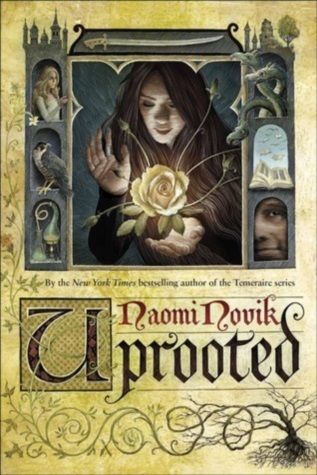As you take this trip, your eyes dance along the covers. They waltz from bright hues to muted tones. Your eyes tango over some bestsellers and linger on a few modern classics. They finally settle on a gold cover packed with images of a dragon and rose. Everything from the font to the coloring resembles a fairytale. You decide to pick it up and read the inside blurb. It’s about a young woman who must leave her small village to serve the wizard that protects them. It reminds you of one of the many Grimm’s fairytales you read growing up. There’s drama, adventure, intrigue, and a dark magical force that lives deep in the forest. You are delighted by the magical images on the cover. You decide to purchase it and make your way to the cash register. Sounds like a normal buying experience, right? You wander, find something that catches your eye, and look a little further. But…isn’t that what we’ve been told not to do? You know, judge a book by its cover? How does this philosophy fit into your book buying experience? Well, before we get there, let’s take a look at what goes into a book cover. This assumption is one of the reasons why I think “don’t judge a book by its cover” is bad advice, but that’s not all. Read on to find out my other reasons.
How does this apply to authors?
Final Thoughts
Readers are going to keep on reading and judging based on a whole host of criteria. The cover is just one of the many factors that are taken into account. Like other aspects of a book, it holds valuable information about the story kept inside. Disregarding it is bad advice. Instead, why not try judging a book by its cover? Maybe next time you peruse the shelves of your neighborhood bookstore or scroll through the numerous titles listed online, you can select books purely based on the cover. You never know, that could tell you everything you need to give that book a chance. And if we’re not judging a book by its cover, what is the point of the cover in the first place? Why have a cover if people insist that you shouldn’t take it into account when assessing a book? Good books are planned out well. They pay special attention to major elements like the plot, characters, and central conflict, but they don’t forget about the details. This includes the cover, artwork, design, and so on. Everything is put in place for a reason. We should respect that. This leads me to my next point. Third, disregarding the cover also disregards the hard work of the artist, author, and other personnel involved in creating and publishing the book. Each cover takes a certain amount of skill to complete. There are so many dazzling, charming, and clever book covers. Some covers may look like they were easily put together, but many are exceptional. Wouldn’t this advice disregard the skills, time, and money spent creating the cover? There’s the time spent developing the concept, creating the design, and fine tuning the details. Creating a cover to represent a completed story is hard work! That’s a lot of effort and work for readers to simply glance over. Shouldn’t we be happy that people are using the cover to form an opinion? We can see this in other genres too. Take a cozy mystery for example. These books often include a pun in the title and cute images on the cover. For the most part, we all expect to see certain things on covers of particular books. For regency romance books, don’t we need a cover that features a grand estate and dresses with a high waisted bodice? Many genres abide by this idea, focusing on imagery that resonates with the story and audience. In this way, covers give us a taste of what will be in between the pages. It can serve as an appetizer or the entrance of a restaurant. The cover shows you what you could enjoy from the book. It helps the reader decide if this book is what they are looking for. Of course, many covers can be misleading. They can evoke images of fun in the sun or a summer fling while also hiding the intense depressive state of the main character. To this, all I can say is a cover like that is also a choice. Maybe the author, publisher, or other personnel wanted to reel in a particular demographic that wouldn’t necessarily try this book. Plus, even when a book turns out different than expected, the overall experience can still be positive. On another note, if you’re not reaching the readers that you are targeting because of something like the cover, then that’s more of a publishing or marketing problem. A cover can be used to fit a book into a certain category and make it appeal to a particular audience. Whether the cover fits the content of the book or not isn’t truly the reader’s problem. They’re merely enjoying the fruits of this industry. Many of them are not privy to what happens behind the scenes. Like this topic? Check out these other articles: The Value of the Book Cover: My Favorite Way to Discover Books in Libraries I’ll Take a Side of Illustration With That It’s Okay to be an Adventurous Reader

